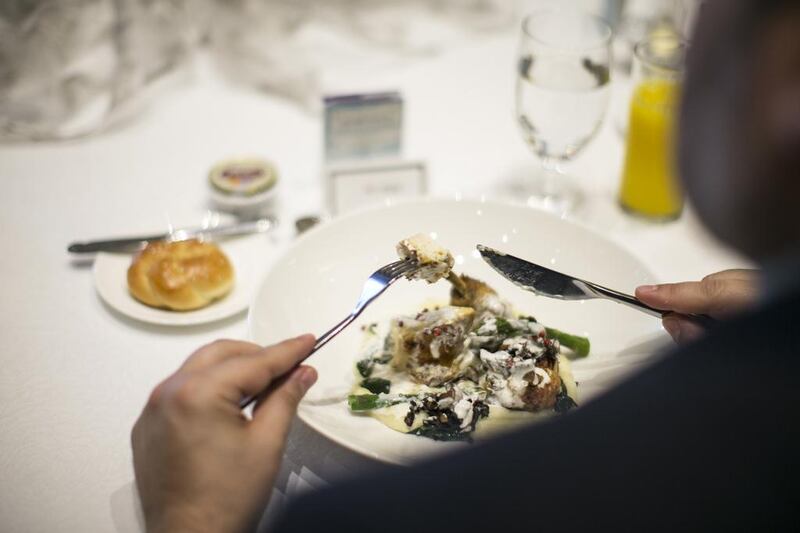After sitting through a course in table manners last week, I’m confident I have previously ruined many chances to impress at formal dinners simply because I did not sit down properly or forgot to place my napkin to the left of the plate when I was ready to leave the table.
Participants at the Dining Like A Diplomat workshop, organised by the Protocol School of Washington in Dubai last week, were told that dining etiquette can have a big effect on your social standing, make or break business deals and even influence diplomatic decisions.
“We live in a world where people are compared and judged all the time,” says trainer Ghassan Hajjaj. “And we are always looking to give the right impression. So when we know proper dining etiquette, you can really focus on much more important things such as conversation.
“When you are at a business dinner or formal gathering, you aren’t there to fill your stomach. It’s an opportunity to network, exchange knowledge and you want to focus on that. But if you are sitting there and going, ‘Oh dear, which fork do I use now?’ or ‘Am I going for the right glass?’ you do not have the capability to pay attention to that.”
The school trains diplomats, ambassadors and high-level executives around the world in international protocols, cultural orientation, business etiquette and communication skills. It started offering dining etiquette workshops in the UAE after spotting a demand for such skills among socialites.
“Dining skills say a lot about a person,” says Hajjaj. “And not knowing it can be more damaging than you would think, especially for people in high positions. If you haven’t learnt to eat correctly, what else did you miss learning on the way to growing into the position you are in.”
Table manners are about more than using the correct cutlery and napkin protocol. There are more subtle behaviours, many of which go back centuries and stem from aristocratic ceremonies in different cultures.
Modern table manners date to the 15th century, when it was compulsory for children to learn them. The two most widely accepted styles of dining are continental and American. While both societies ate the same way, forks in the right hand, until the 1840s, the continental way of eating now involves holding the fork in the left and knife in the right hand while eating.
“It is not mannerly to place your elbow on the table while eating,” says Hajjaj.
“Just your wrists. And the appropriate way of sitting is to not lean back, but to sit up straight on a high-backed chair.”
Being a guest at a formal dinner also involves adhering to the culture of the hosts. Hajjaj tells how two spies from the United States were discovered in Germany during the First World War because of their table manners.
The Arabic and Asian styles of eating involve using your hands and chopsticks, respectively.
“When eating with your hands, the food should be held with your tip of your fingers and lightly pushed into the mouth.”
In Japan, sticking chopsticks upright in a bowl of rice causes uneasiness as it is associated with death.
“It is usually incense that is placed upright that way in funeral ceremonies,” says Hajjaj. “To rest the chopsticks, you must use the hashioki, chopstick rest provided or lie them laterally across the rice bowl.”
As for the place setting, Hajjaj suggests using the mnemonic “BMW” to avoid embarrassing situations.
“This makes life easier,” he says. “When we go out dining, we have lots of plates, the silverware, glasses, which can be confusing. The important thing to remember is bread is always on the left, your meal is in the centre and your water is on your right. BMW. If you remember this you know which bread plate and glass of water is yours.”
Dining etiquette is also a window into a country’s culture. Middle Eastern gatherings, for example, lay out the table for sharing.
“After the meal, bukhoor or incense is passed around and this is a signal that it is time for you to leave,” he adds.
“You do not hang around and make conversation after this, like is the case in the West after dinner.”
Hajjaj says understanding these nuances takes time and practice, but shows that effort has been made to understand the local culture.
“Very few people we meet get to know the actual person we are and so in gatherings we tend to generalise very quickly based on impressions,” he says.
“So what you want to do is represent yourself and your society and at the same time show you accept their culture and traditions.”
“You might not be able to learn it all overnight, but one of the best investments in being successful is to have dining protocol training.”
• The Protocol School of Washington organises Dine Like a Diplomat workshops on request. Email infomena@psow.edu or call 04 375 7555
aahmed@thenational.ae






